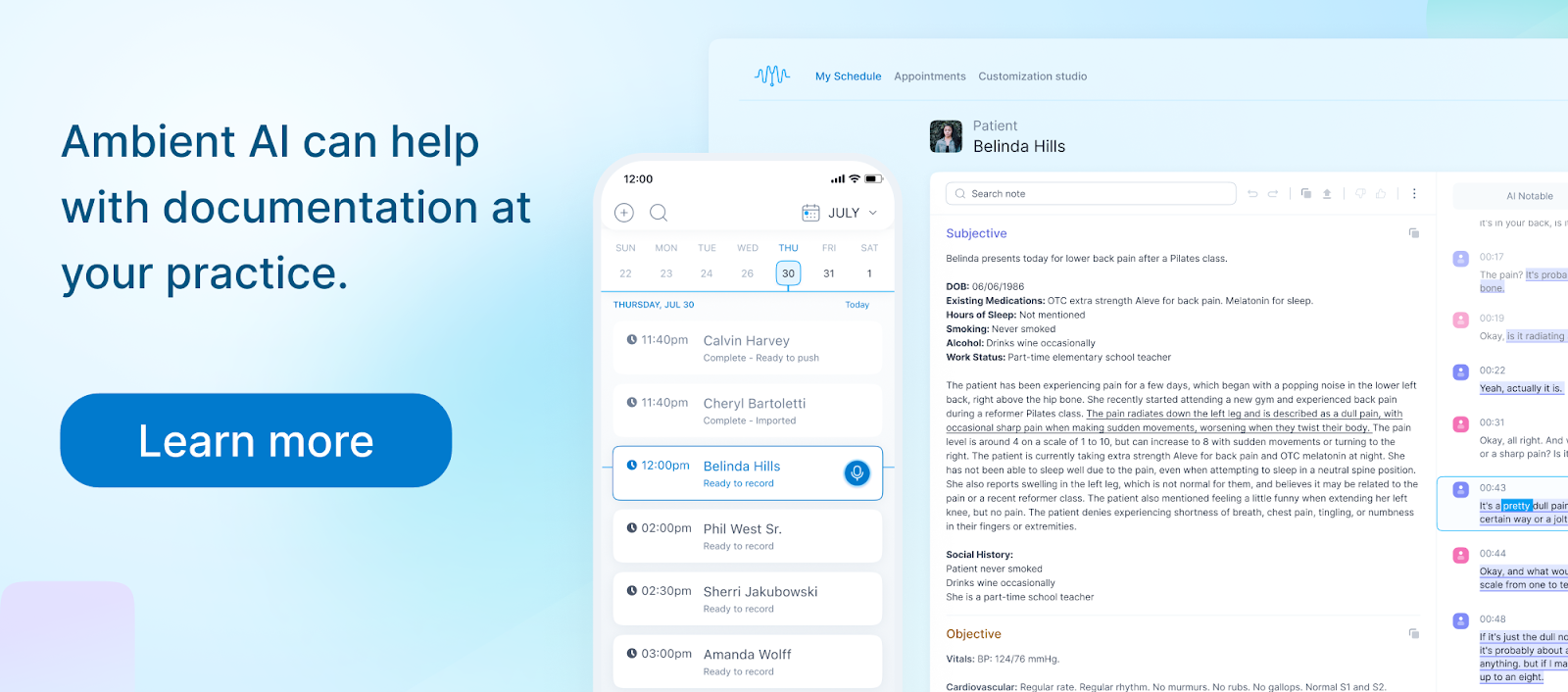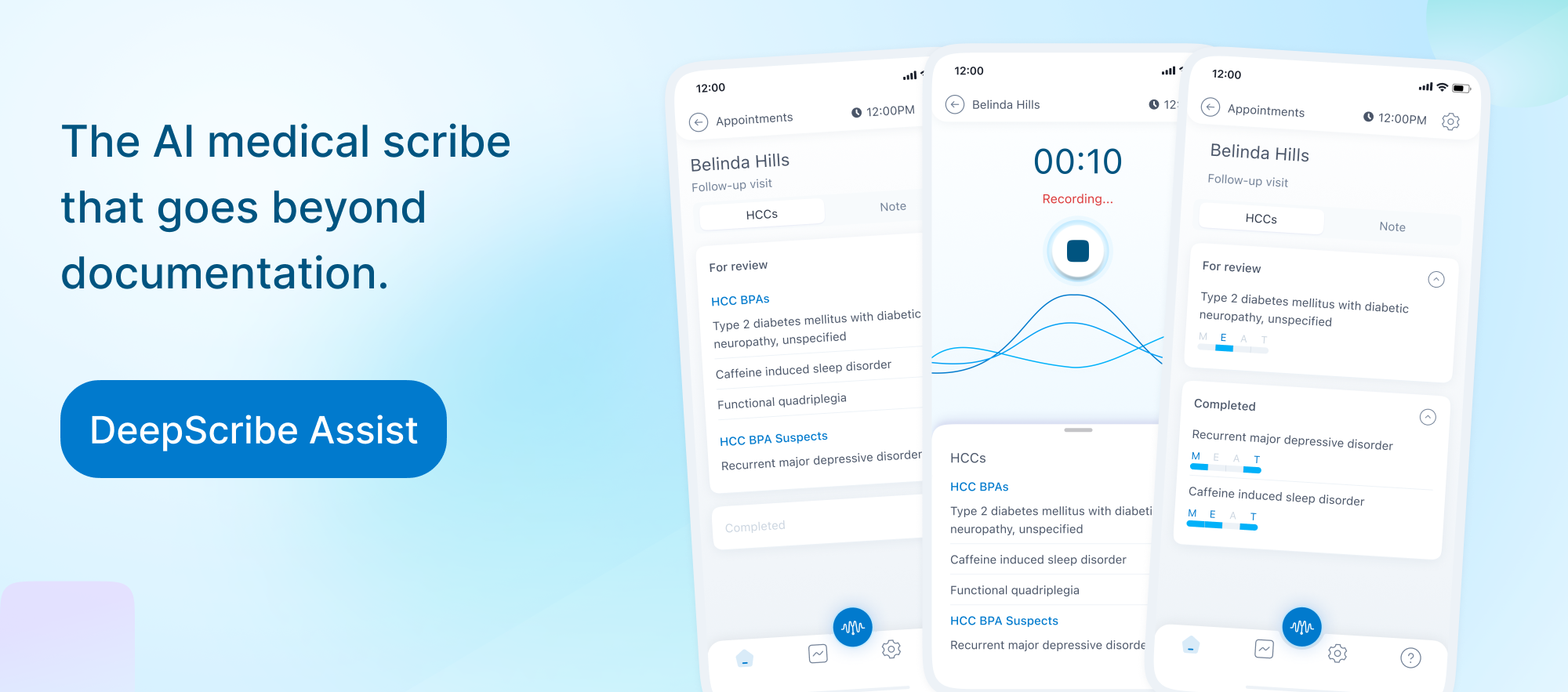What is a Medical Scribe?
What is a scribe in healthcare? A medical scribe is a person hired by a clinician or healthcare organization to document medical information during a patient encounter and enter it into the electronic health record system (EHR).


Updated 11/21/2024
What Is a Medical Scribe?
A medical scribe is a person hired by a clinician or healthcare organization to document medical information during a patient encounter and enter it into the electronic health record system (EHR). By managing the bulk of a clinician’s medical documentation, scribes allow healthcare providers to focus more intently on patient care during the visit. Within the past couple of years, the idea of efficient medical scribing has shifted to the use of AI: an ambient AI medical scribe listens to the patient conversation and generates the clinical note for the EHR automatically.
The Emergence of Medical Scribes: Why Doctors Need Help with Documentation
While medical scribes aren’t new, their prominence in healthcare has grown significantly since 2010. This surge coincided with the passage of the Health Information Technology for Economic and Clinical Health (HITECH) Act, which financially incentivized healthcare organizations to adopt EHR systems, thus fundamentally changing the way providers deliver and document care.
With these new systems came an unprecedented administrative burden. Clinicians suddenly found themselves navigating complex documentation requirements and clunky technology that consumed significant time and mental energy. Detailed note-taking, comprehensive charting, and meticulous record-keeping became mandatory – often at the expense of patient interaction and clinician well-being.
Doctors were faced with an impossible choice: either document during patient visits, potentially compromising face-to-face interactions, or complete extensive paperwork after hours, risking burnout and personal exhaustion. Medical scribes emerged as a plug-and-play solution to this systemic challenge and by 2010 became one of the fastest-growing professions in the United States.

What Do Medical Scribes Do?
Medical scribes perform several key tasks:
- Real-time documentation during patient visits
- Recording the history of present illness (HPI) and family history
- Assisting with the review of systems (ROS)
- Inputting information into the EHR system
Secondary tasks may include:
- Scheduling
- Pre-visit prep
- Assisting with referrals and orders
- Post-visit follow ups
These tasks are essential for maintaining accurate patient records and ensuring proper reimbursement for healthcare providers. With scribes in the room, clinicians can devote more attention to patient care and clinical decision-making.
How Has Medical Scribing Evolved Over Time?
The role of medical scribes has evolved significantly over time, adapting to changing healthcare needs and new technology. This evolution can be seen in three distinct phases:
- Traditional In-Person Scribes: The original model, where scribes accompany clinicians in the exam room during patient encounters
- Virtual Scribes: A more flexible, cost-effective option that gained significant popularity during the COVID-19 pandemic.
- AI Medical Scribes: The latest evolution in clinical documentation tools, representing a significant leap forward in healthcare technology.
What Is an AI Medical Scribe?
AI medical scribes use artificial intelligence, machine learning, and natural language processing to ambiently capture the conversation between doctor and patient and generate clinical notes. This ambient AI technology works in the background, automatically documenting the encounter without requiring direct input from the clinician.
AI scribes offer several advantages over traditional medical scribes:
- Consistency in documentation
- No turnover
- Reduced training requirements
- Cost-effectiveness
- 24/7 availability
- Scalability across healthcare systems
- Direct EHR integration
Recommended reading: Texas Oncology uses DeepScribe AI to stop clinician burnout, connect with patients, and automate coding
How Do AI Medical Scribes Impact Clinician Workflows?
AI medical scribes have the potential to significantly improve clinician workflows by:
- Reducing time spent on documentation
- Allowing for more direct patient interaction
- Minimizing after-hours charting
- Improving work-life balance for healthcare providers
By automating the documentation process, AI scribes enable clinicians to focus on what matters most – providing high-quality patient care.
The Importance of Specialized AI Medical Scribes
AI medical scribes offer a promising solution to healthcare documentation challenges, but not all are created equal. As adoption grows, the gap between general, one-size-fits-all solutions and those designed for specialty-specific needs has become increasingly evident.
While general solutions may easily handle more standard, templated encounters like annual exams, they can struggle with complex visit types. The most effective AI medical scribes are those that are customizable, specialty-specific, and build on large, diverse datasets.
Customizable
Every clinician has their own way of charting, and many see documentation as the primary output of their care - something they can stand behind and put their stamp on. Instead of sterilizing documentation with AI, clinicians should be able to document in a way that reflects their nuance and style of care. Customizable AI that can be fine-tuned at every level helps increase scalability and adoption.
Specialty-Specific
Different medical specialties have unique documentation needs. For example, an orthopedic surgeon needs AI that understands the nuances of documenting range of motion assessments, while an oncologist requires AI that can accurately capture complex treatment plans, side effect discussions, and complicated medication names. Adopting AI that can document nuanced visit types is critical for successful adoption, particularly among multi-disciplinary practices looking to deploy a singular solution.
Built on large, diverse datasets
The most effective AI medical scribes are trained on vast, diverse datasets of real-world clinical conversations, encompassing a wide range of medical specialties, patient demographics, and clinical scenarios. This comprehensive training allows the AI to understand complex medical terminology, recognize patterns in doctor-patient interactions, and accurately capture the nuances of different specialties.
Recommended reading: The pitfalls of one-size-fits-all AI solutions.
The Future of AI Medical Scribes: Ambient Intelligence
Just as AI medical scribes succeeded traditional scribes, Ambient Intelligence is considered to be the next evolution of ambient AI. Ambient intelligence goes beyond documentation to deliver real-time insights during patient encounters. By analyzing conversations, patient history, and clinical data in real time, to serve valuable information to clinicians at the point of care.
One notable current application of ambient intelligence is here today: HCC code capture for value-based care programs. This technology guides physicians to each relevant condition and makes it easier than ever to address every HCC code as part of the conversation, in real time.
Recommended reading: Context Awareness in Ambient AI Clinical Notes: Responding to the Moment of Care
As ambient intelligence evolves, it has the potential to revolutionize healthcare delivery in a few key ways:
- Enhanced decision support: Providing real-time, evidence-based recommendations to aid in clinical decision-making
- Proactive care: Identifying potential health risks such as harmful drug interactions and suggesting preventative measures based on patient data.
- Personalized care plans: Tailoring treatment plans based on individual patient data, preferences, and the latest research.

Conclusion
Medical scribes have evolved from in-person assistants to cutting-edge AI partners. In the process, AI medical scribes are restoring a more personal engagement between clinicians and patients – with a greater focus on the patient’s story – and transforming the process of documentation. In the environment of care, especially for complex and chronic cases, this is imperative.
However, not all AI solutions are created equal. The right AI medical scribe solution should be customizable, specialty-specific, and built on diverse datasets.
Ambient intelligence represents the next frontier, offering real-time insights and enhancing decision support at the point of care. At DeepScribe, developments like DeepScribe Assist and context awareness put us at the forefront of this transformation, helping healthcare providers not only reclaim time and reduce burnout, but provide more holistic, all-encompassing patient care.
Ready to experience the future of medical documentation?
See how DeepScribe can transform your practice.
text
Related Stories
Realize the full potential of Healthcare AI with DeepScribe
Explore how DeepScribe’s customizable ambient AI platform can help you save time, improve patient care, and maximize revenue.




